Red Oak Tree: Leaves, Bark, Acorns (With Pictures) – Identification and Care Guide
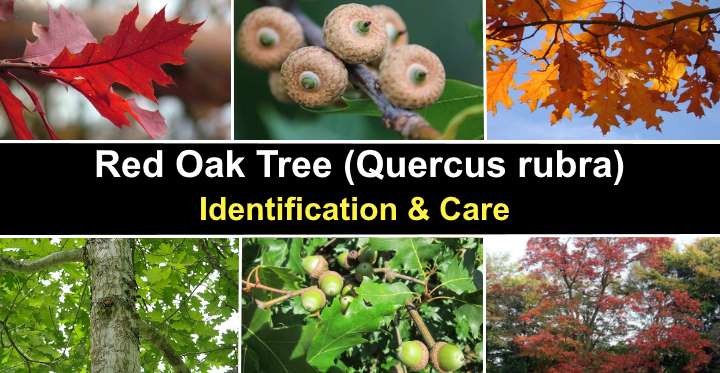
A red oak tree is a fast-growing deciduous tree with dark green lobed leaves with bristle tips, pale green catkins (flower clusters), and a broad-spreading irregular crown. Red oak trees are famed for their spectacular fall colors in vibrant shades of red, burgundy, copper, and bronze. Like all oak species, the red oak produces acorns—rounded brownish nuts hanging in warty caps.
There are several species of oak classified as red oak. These include native oak trees like the scarlet oak, eastern black oak, southern red oak, and Shumard oak. However, the most common type of red oak tree is the northern red oak (Quercus rubra). This majestic tree is simply referred to as the red oak or champion oak.
This article is a comprehensive guide to identifying the red oak tree (northern red oak). Descriptions and pictures of red oak leaves, acorns, bark, and flowers will help recognize this native tree in the landscape. Also, you will find helpful tips on planting acorns if you want to grow a red oak in your garden.
Red Oak Tree Facts
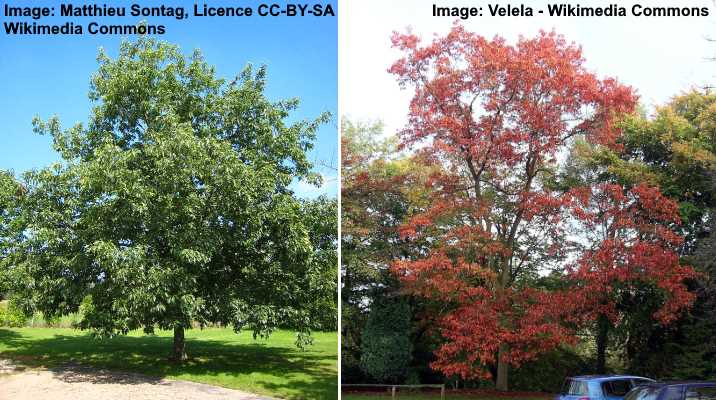
Red oak (Quercus rubra) is a fast growing long-lived deciduous tree with beautiful fall colors
The red oak (Quercus rubra) is a broadleaved deciduous tree that grows 60 to 90 ft. (18 – 28 m). The stately tree has a spreading crown with an irregular shape growing up to 75 ft. (22 m) wide. Red oaks have trunks measuring 1.6 to 3.2 ft. (0.5 – 1 m) wide, with some specimens measuring over 6 ft. (2 m) in diameter.
Red oak is identified in the landscape by its branches growing at right angles, luscious green lobed leaves, small brown acorns, and a straight, erect trunk.
Red oak growth rate: Red oaks have rapid growth. Growing in full sun and under optimal conditions, the red oak tree can grow 2 to 3 ft. (0.6 – 1 m) per year. So, after growing for ten years, red oak trees can already be 16 – 20 ft. (5 – 6 m) tall.
How long do red oak trees live: Red oaks can live for up to 400 years, especially in deep, moist, and well-drained soils. This growth habit is typical of most species of oak trees. However, the white oak can live for five to six hundred years.
Red oak tree growing requirements: Red oaks thrive in USDA zones 5 through 9. They perform best in full sun when growing in well-drained, slightly acidic soil.
Growth characteristics of red oak trees are that they leaf out in spring and produce clusters of dangling green flowers at the same time. In addition, red oak fruit (acorns) mature on the tree for two seasons. Therefore, you can usually identify red oak in a winter landscape by the small, round acorns on the tree.
There are a few ways to tell a red oak apart from white oak. For example, red oak leaves have pointed lobes with tooted or bristle-like points. White oak leaves usually have rounded lobes. Additionally, the bark on red oaks is dark reddish-brown with pronounced ridges giving them a shiny appearance. White oak bark has noticeable shallower ridges.
Red Oak Tree Leaves
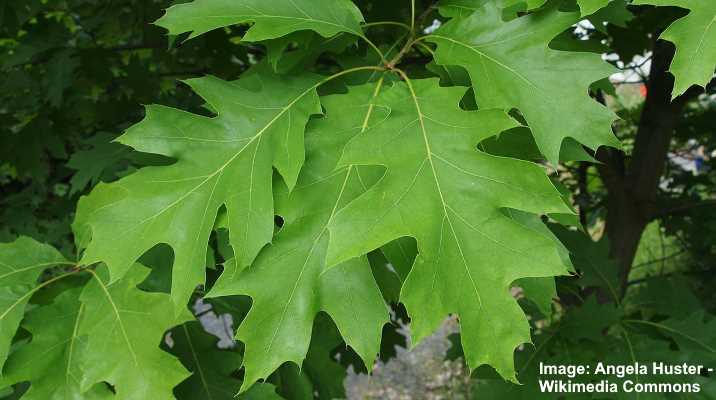
Red oak leaves
Leaves growing on a red oak tree are obovate, with the narrower end at the base. The identification features of the leaf are its nine to eleven shallow lobes with irregular bristle tips. Red oak leaves measure 5” to 10” (13 – 25 cm) long and up to 6” (15 cm) wide.
Red oak tree leaves are dark green with a glossy shine on the upper side. The leaf undersides sometimes have fine hairs and a lighter yellowish-green color. In the fall, red oaks transform the landscape with vibrant red colors.
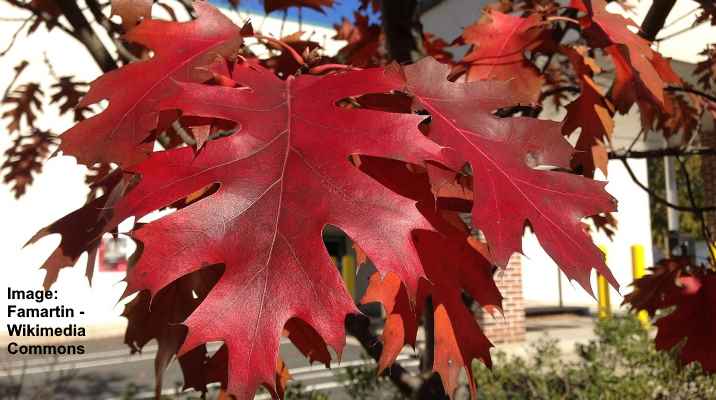
Red oak leaves in autumn
Leaves from a red oak tree grow on relatively short petioles in an alternate, simple arrangement. Some red oak specimens have leaf stems and veins that develop a rich red color from midsummer until the fall when all the leaves turn a brilliant red.
Red Oak Tree Bark
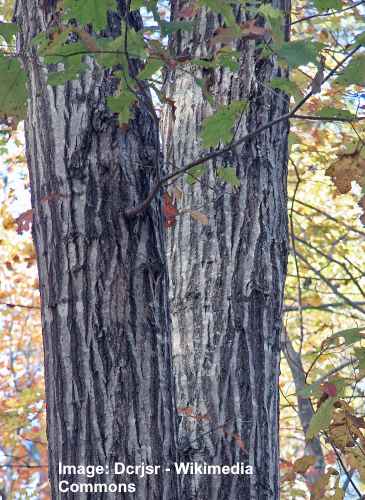
Red oak tree bark
Bark on red oak trees is a distinctive feature helping to identify it from white oak. Red oak bark is reddish-brown to dark gray. As the oak matures, the bark develops flat-topped gray ridges and has deep furrows. A distinctive feature of the bark is the shiny stripes that seem to appear in the center of the ridges.
Red Oak Tree Flowers
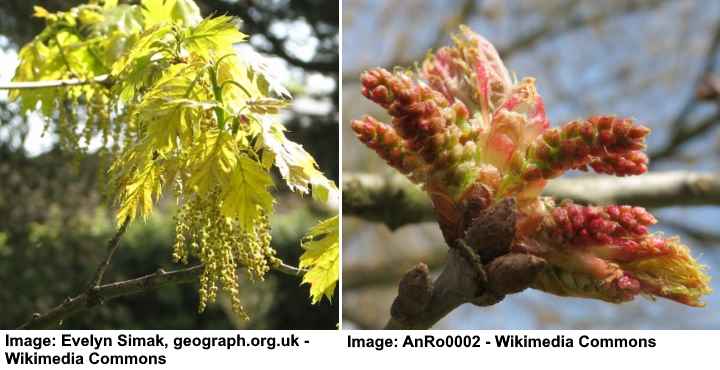
Red oak tree male flowers (left) and female flowers (right)
A red oak tree blooms with clusters of insignificant flowers which are yellowish-green. Red oaks are described as monoecious, producing male and female flowers on the same tree. The male red oak flowers are dangling catkins about 4” (10 cm) long. Female flowers are reddish green and grow as small spikes on the tip of the branches in clusters of two to five.
Red Oak Tree Fruit (Acorns)
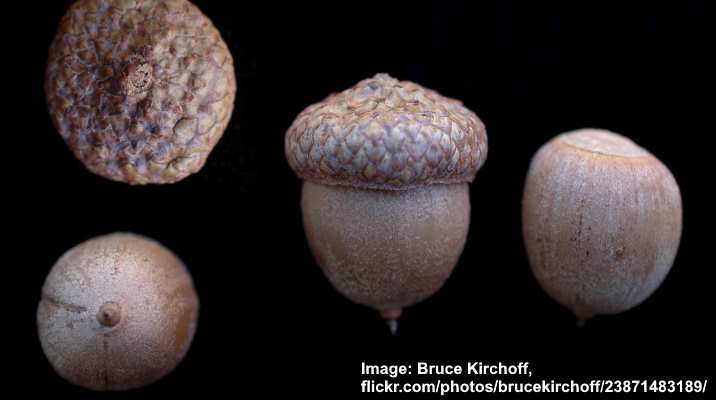
Red oak acorns
Red oak tree fruit is the most distinctive characteristic of the nut-bearing tree and is the best way to identify the oak species. Red oak produces acorns which are rounded, barrel-shaped brown nuts with pointed tips. The acorns have a thick leathery shell covering a single seed.
A red oak acorn also has a unique slightly knobby flat cup-shaped cap covering one-third of the nut. Acorns from the red oak measure about 1” (25 mm) long. Like all red oak species, the acorns mature on the trees for two years. Compared to white oak acorns that tend to be oval and elongated, red oak acorns are shorter and stouter.
Related reading: How to identify types of acorns.
How to Identify Red Oak
To identify a red oak in a landscape, look for its distinctive leaves, acorns, and deeply ridged, dark gray bark. Red oaks have dark green leaves with 9 to 11 deeply pointed lobes and toothed tips. The acorns are 1” (25 mm) long, with a rounded end, pointed tip, and thin flat cap.
How to Plant an Acorn
Growing an oak tree from an acorn can be tricky as the oak tree seeds (acorns) are tricky to sprout. If you plan to plant an acorn, you’ll need to collect a large handful of the brown nuts in the fall. However, you will need to store the acorns in damp, cool conditions until the following spring.
Red acorns sprout best if they have some stratification—a cooling period over the winter. They should then be ready for planting the following spring.
To plant an acorn, remove the caps from the seeds. Then place them in a bucket of water and discard any that float. The next step is to prepare individual planting pots with a mixture of peat moss and potting soil. Lastly, put the acorn on its side and press about 1” (25 mm) into the soil and water thoroughly.
How to Grow Red Oak Saplings (Baby Oak Tree)
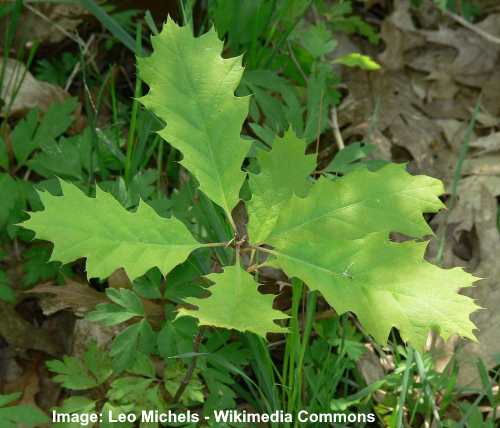
Red oak sapling
It takes two to four weeks for an acorn to germinate and around eight weeks for roots to show. You can transplant it to the garden as soon as the red oak sapling leaves open. Red oak thrives in full sun, so choose the sunniest part of the garden to grow the baby oak tree.
To plant your red oak sapling, dig a hole twice as wide as the pot and root ball. Then, carefully plant the baby oak tree in the hole and backfill with organically-rich soil. Ensuring that the root crown is level with the soil surface is vital.
You don’t need to fertilize a newly-planted oak tree.
To help establish your red oak saplings and make them thrive, water them daily for the first 14 days. Also, you will need to protect the oak sapling from wildlife. Therefore, you will need chicken wire around it to stop deer and other animals from eating the tender leaves. Keep the baby oak protected until it is 5 ft. (1.5 m) tall.
During the first three years, water the oak tree once a month to keep the ground moist. This helps develop a strong root system and grow a healthy, robust red oak tree.
Some pruning is also required for your young oak tree to develop an attractive shape. After the tree has been growing for at least 12 months, you can start pruning it. Trim off lower branches that are less than 2” (50 mm) in diameter—a process called “limbing up a tree.”
Where to Plant Red Oak Tree
Choose a spot where the red oak tree will get plenty of sunlight. All oak trees grow best in moist but well-drained, acidic soils. However, red oaks are robust trees and will grow in most soil types. In addition to these conditions, the established red oaks also tolerate periods of drought, flooding, and salty air.
Try to ensure the red oak doesn’t get too much shade. A lack of sunlight can result in issues like pests, diseases, and poor foliage growth. Also, red oak trees growing in full shade tend to lose their vibrant scarlet-red colors in fall.
Although reasonably robust to challenging conditions, red oaks need acidic soil to thrive. The best type of soil to plant a red oak is clay, loamy, or sandy soil. Soil lacking in organic matter can cause the lush dark green leaves to wilt and turn yellow. Shallow, alkaline soil can result in a poor root structure that affects the tree’s growth.
Red Oak Tree (Quercus rubra) Care Guide
Red oaks have minimal care requirements when established. During the first few years after planting, water them regularly to strengthen the root system. Mature trees don’t require additional watering or fertilizing unless growth seems slow. Prune a red oak tree once a year in late winter while young to develop its shape.
How to Water Red Oak Tree
Water a newly-planted oak tree once a month by deeply watering the roots. After three years, a red oak only requires additional watering especially during dry weather. Usually, average rainfall is enough to provide as much irrigation as a red oak requires.
To ensure healthy growth, a good layer of organic mulch—pine bark or pine needles—can help to keep the ground moist and prevent weeds from growing. Spread 3 to 4 inches (7.5 – 10 cm) of mulch over the root area, leaving a 3” (7.5 cm) gap around the trunk.
Red Oak Tree Fertilization
Red oaks don’t require additional fertilization when growing in acidic soil or beside well-fertilized lawns. However, adding organic mulch in spring is usually enough to keep the soil healthy. If growth seems slow, you could test the soil for deficiencies. Then you can apply the appropriate tree fertilizer with the correct NPK ratio.
How to Prune Red Oak Tree
Pruning an oak tree when it’s young is relatively straightforward. First, you should locate the strong, central trunk and then remove lower, weak branches. You can also cut back two or three branches of a similar thickness to the main trunk. This prevents branches from competing for space and nutrients.
The best time to prune a red oak tree is late winter until early March.
What about pruning mature red oak trees? It is usually best to call a professional arborist or tree surgeon to trim dead or decaying branches.
Pests Affecting Red Oak Growth
Red oaks are susceptible to various types of pests like aphids, lace bugs, weevils, caterpillars, and oak sawflies. The good news is that these white and black bugs don’t do enough damage to affect the tree’s overall health.
However, identifying tree pests and using appropriate control methods is vital for keeping your tree’s appearance healthy.
Aphids that infest oak trees are grayish-black bugs that feed on plant tissue. Giant bark aphids are commonly found on red oak trees. The damage these bugs cause may result in twig die-back. However, the health of the tree is rarely affected.
Related reading: How to kill aphids on outdoor plants.

Giant bark aphid
Acorn weevils are tiny brown beetles that cause hollowed-out red oak acorns. The small beetle lays an egg inside an acorn. When the egg hatches, the larva eats away at the nut until it becomes hollow.

Acorn weevil
Oak sawfly larvae damage oak tree leaves by feeding on the leaf tissue, eventually skeletonizing them. The best way to deal with these yellow and black caterpillars is to remove them by hand. However, this may not be effective if you have a large oak tree.
Yellownecked caterpillars can cause damage to the appearance of a red oak tree by stripping it off foliage. These striped black and white caterpillars usually prefer young red oak trees. To get rid of these leaf-destroying caterpillars, handpick them and drop them into a bucket of soapy water.
Diseases Affecting Red Oak Growth
Red oak tree foliage can suffer in cool, damp conditions or if the ground is too soggy for extended periods. Common diseases affecting red oak leaves are anthracnose, oak wilt, oak tatters, and leaf blistering.
Here are some helpful tips on recognizing diseases affecting red oak trees and what to do about them.
Oak wilt is a fungal disease caused by Ceratocystis fagaceous. The fungal infection is generally spread by beetles that carry spores to the roots. The signs of oak wilt are wilted leaves that turn brown at the edges and along the veins. They will eventually fall off. Unfortunately, the fungal infection can kill a once healthy tree in four to six weeks.
The best way to prevent oak wilt is to avoid pruning red oaks during spring and summer. Usually, professional help is necessary to remedy this severe oak tree disease.
Anthracnose is a fungal disease affecting red oak foliage. The fungus causes unsightly blotches on leaves that can be light to dark brown or black. Sometimes, leaves can drop early if the infection is severe. However, trees usually produce new leaves, and the tree continues to grow without any issues.
Leaf blistering (Taphrina caerulescens) can happen to red oak trees in spring in cooler climates. The foliar disease looks like yellowish-green raised blisters on red oak leaves. The small patches can turn yellow, brown, or gray as the leaves grow. Eventually, the leaves curl and drop. The best way to deal with leaf blisters on a red oak tree is to improve its growing conditions. However, you don’t need to do anything more.
Oak tatters is a leaf disease that affects red oaks. It causes oak leaves to look like animals or caterpillars have chewed them. As leaves emerge from their buds, they become tattered and disheveled. Sadly, there isn’t any research into why oaks tend to develop oak tatter disease. The good news is that trees usually recover from damage quickly and begin growing new leaves again.
Learn about many other types of oak trees and how to identify them.
Related articles:
- White Oak Tree – Identification and Care Guide
- Types of Acorns – Identification Guide
- Live Oak Tree – Identification and Growing Guide
